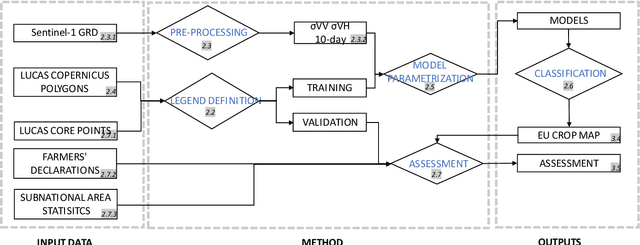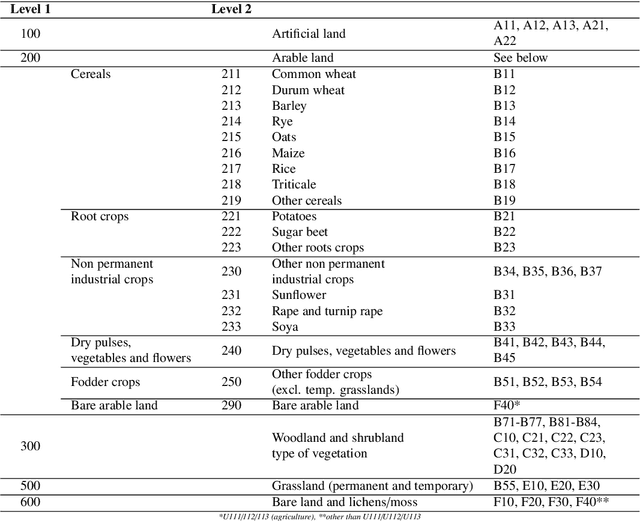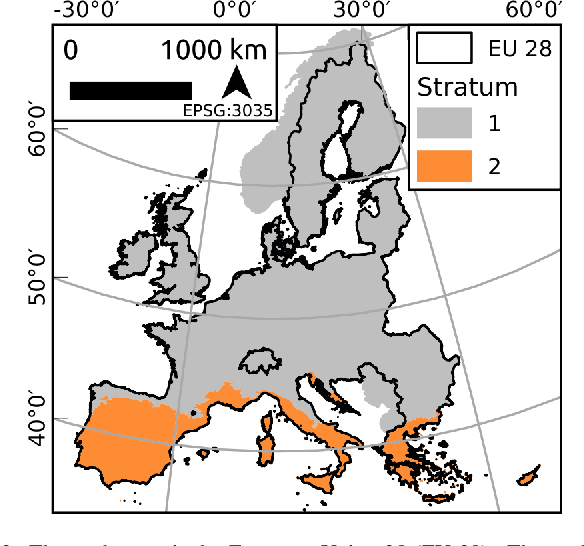Guido Lemoine
Boosting Crop Classification by Hierarchically Fusing Satellite, Rotational, and Contextual Data
May 25, 2023Abstract:Accurate in-season crop type classification is crucial for the crop production estimation and monitoring of agricultural parcels. However, the complexity of the plant growth patterns and their spatio-temporal variability present significant challenges. While current deep learning-based methods show promise in crop type classification from single- and multi-modal time series, most existing methods rely on a single modality, such as satellite optical remote sensing data or crop rotation patterns. We propose a novel approach to fuse multimodal information into a model for improved accuracy and robustness across multiple years and countries. The approach relies on three modalities used: remote sensing time series from Sentinel-2 and Landsat 8 observations, parcel crop rotation and local crop distribution. To evaluate our approach, we release a new annotated dataset of 7.4 million agricultural parcels in France and Netherlands. We associate each parcel with time-series of surface reflectance (Red and NIR) and biophysical variables (LAI, FAPAR). Additionally, we propose a new approach to automatically aggregate crop types into a hierarchical class structure for meaningful model evaluation and a novel data-augmentation technique for early-season classification. Performance of the multimodal approach was assessed at different aggregation level in the semantic domain spanning from 151 to 8 crop types or groups. It resulted in accuracy ranging from 91\% to 95\% for NL dataset and from 85\% to 89\% for FR dataset. Pre-training on a dataset improves domain adaptation between countries, allowing for cross-domain zero-shot learning, and robustness of the performances in a few-shot setting from France to Netherlands. Our proposed approach outperforms comparable methods by enabling learning methods to use the often overlooked spatio-temporal context of parcels, resulting in increased preci...
Crop identification using deep learning on LUCAS crop cover photos
May 08, 2023Abstract:Crop classification via deep learning on ground imagery can deliver timely and accurate crop-specific information to various stakeholders. Dedicated ground-based image acquisition exercises can help to collect data in data scarce regions, improve control on timing of collection, or when study areas are to small to monitor via satellite. Automatic labelling is essential when collecting large volumes of data. One such data collection is the EU's Land Use Cover Area frame Survey (LUCAS), and in particular, the recently published LUCAS Cover photos database. The aim of this paper is to select and publish a subset of LUCAS Cover photos for 12 mature major crops across the EU, to deploy, benchmark, and identify the best configuration of Mobile-net for the classification task, to showcase the possibility of using entropy-based metrics for post-processing of results, and finally to show the applications and limitations of the model in a practical and policy relevant context. In particular, the usefulness of automatically identifying crops on geo-tagged photos is illustrated in the context of the EU's Common Agricultural Policy. The work has produced a dataset of 169,460 images of mature crops for the 12 classes, out of which 15,876 were manually selected as representing a clean sample without any foreign objects or unfavorable conditions. The best performing model achieved a Macro F1 (M-F1) of 0.75 on an imbalanced test dataset of 8,642 photos. Using metrics from information theory, namely - the Equivalence Reference Probability, resulted in achieving an increase of 6%. The most unfavorable conditions for taking such images, across all crop classes, were found to be too early or late in the season. The proposed methodology shows the possibility for using minimal auxiliary data, outside the images themselves, in order to achieve a M-F1 of 0.817 for labelling between 12 major European crops.
From parcel to continental scale -- A first European crop type map based on Sentinel-1 and LUCAS Copernicus in-situ observations
May 21, 2021



Abstract:Detailed parcel-level crop type mapping for the whole European Union (EU) is necessary for the evaluation of agricultural policies. The Copernicus program, and Sentinel-1 (S1) in particular, offers the opportunity to monitor agricultural land at a continental scale and in a timely manner. However, so far the potential of S1 has not been explored at such a scale. Capitalizing on the unique LUCAS 2018 Copernicus in-situ survey, we present the first continental crop type map at 10-m spatial resolution for the EU based on S1A and S1B Synthetic Aperture Radar observations for the year 2018. Random forest classification algorithms are tuned to detect 19 different crop types. We assess the accuracy of this EU crop map with three approaches. First, the accuracy is assessed with independent LUCAS core in-situ observations over the continent. Second, an accuracy assessment is done specifically for main crop types from farmers declarations from 6 EU member countries or regions totaling >3M parcels and 8.21 Mha. Finally, the crop areas derived by classification are compared to the subnational (NUTS 2) area statistics reported by Eurostat. The overall accuracy for the map is reported as 80.3% when grouping main crop classes and 76% when considering all 19 crop type classes separately. Highest accuracies are obtained for rape and turnip rape with user and produced accuracies higher than 96%. The correlation between the remotely sensed estimated and Eurostat reported crop area ranges from 0.93 (potatoes) to 0.99 (rape and turnip rape). Finally, we discuss how the framework presented here can underpin the operational delivery of in-season high-resolution based crop mapping.
 Add to Chrome
Add to Chrome Add to Firefox
Add to Firefox Add to Edge
Add to Edge